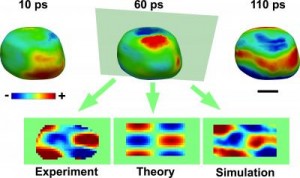A Jan. 20, 2014 news item on Nanowerk highlights a new phase in laboratory physics (Note: A link has been removed),
Many of the most interesting things in nature – from spectacular lightning strikes to the subtlety of life itself – are transient, or far-from-equilibrium. To discover the secrets of far from equilibrium states, physicists need simple yet appealing laboratory systems. Now a researcher at the London Centre for Nanotechnology [UK] has collaborated with workers in Grenoble (France), Cardiff [Wales], Oxford [UK] and Kitakyushu (Japan), to create just such a system in the magnetic material known as “spin ice” (“Far-from-equilibrium monopole dynamics in spin ice”).
The Jan. 19 (?), 2014 (?) London Centre for Nanotechnology (LCN) research brief by Steve Bramwell, which originated the news item. explains ‘spin ice’ in greater detail and the trickery employed by the scientists’,
Spin ice is an unusual magnetic material in that it contains the magnetic equivalent of electrical charges – so called magnetic monopoles. It has attracted great interest on account of the currents of these charges forming a magnetic equivalent of electricity or “magnetricity”.
The number of magnetic monopoles in spin ice diminishes as the temperature goes down in much the same way as does the number of electrical charge carriers in semiconducting materials such as silicon – the basis of the electronics industry. The monopoles or charges disappear at low temperatures by positive and negative charges annihilating each other.
The researchers found a trick that used magnetic fields to create a hot “gas” of magnetic monopoles in very cold surroundings. The surroundings then sucked the heat out of the magnetic monopole gas, resulting in many magnetic monopoles trapped at a fraction of a degree above the absolute zero. The frozen monopoles no longer annihilated each other but instead could be made to flow by applying magnetic fields.
“Our low temperature experiments will tell us a lot about how magnetic monopoles move, as well as about the physics of far-from equilibrium systems in general” explains Prof. Steve Bramwell.
The researchers have provided this artist’s illustration of their work,
![Figure: Artist’s impression of a hot gas of magnetic monopoles in very cold surroundings. Eventually the surroundings suck the heat out of the monopole gas leaving it frozen at low temperature. [downloaded from http://www.london-nano.com/research-and-facilities/highlight/frozen-magnetic-monopoles-create-new-laboratory-physics]](http://www.frogheart.ca/wp-content/uploads/2014/01/FrozenMagneticMonopoles--230x300.jpg)
Figure: Artist’s impression of a hot gas of magnetic monopoles in very cold surroundings. Eventually the surroundings suck the heat out of the monopole gas leaving it frozen at low temperature. [downloaded from http://www.london-nano.com/research-and-facilities/highlight/frozen-magnetic-monopoles-create-new-laboratory-physics]
Far-from-equilibrium monopole dynamics in spin ice by C. Paulsen, M. J. Jackson, E. Lhotel, B. Canals, D. Prabhakaran, K. Matsuhira, S. R. Giblin, & S. T. Bramwell. Nature Physics (2014) doi:10.1038/nphys2847 Published online 19 January 2014
This paper is behind a paywall with several payment options.
